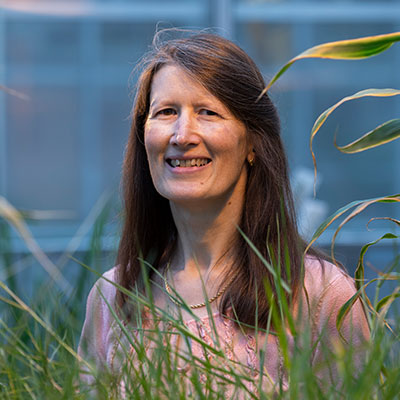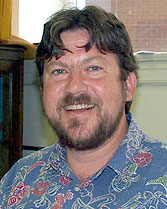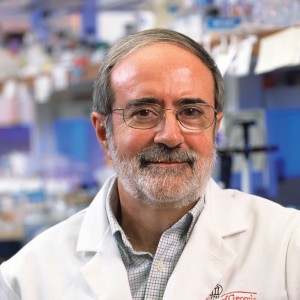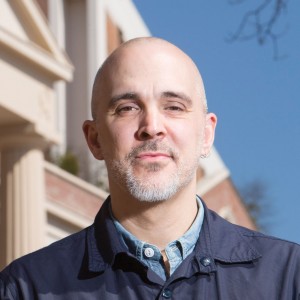Katrien Devos
Distinguished Research Professor 2020

Previous Award
- Creative Research Medal 2017

Previous Award
 Distinguished Research Professor 2004
Distinguished Research Professor 2004Gary D. Grossman, Professor of Animal Ecology, studies freshwater fish ecology and focuses on how complex fish populations interact both with other species and with the ever-changing environment. He has made fundamental contributions in three areas: understanding the role of environmental change on community structure and resource use; providing new insight on the role of competition in community structure; and developing mathematical habitat selection models. His long-term stream studies – which examine fish behavior, species interactions and community structure – will help track the effects of global climate change on freshwater fish communities. Dr. Grossman and his collaborators have examined the effects of environmental changes, competitors and predators on stream fish community structure in Coweeta Creek, N.C. Recent work includes studies of invasive freshwater species, landscape influences on stream fish and population-level molecular genetics. Among his more than 50 journal articles, two monographs published in Ecological Monographs and Ecology of Freshwater Fishes, based on more than 10 years of research, stand out for their contributions to understanding factors that influence community structure and microhabitat use by freshwater fish in streams. Because his research program tackles both basic and applied questions, his findings have implications for stream management.

Yiping Zhao, professor of physics, has made tremendous contributions to the field of nanotechnology. He has developed a method to rapidly and accurately detect viruses, bacteria and chemical contaminants using a technique known as surface enhanced Raman spectroscopy, or SERS, which measures the change in frequency of a laser as it scatters off a compound. The signal produced by Raman scattering is inherently weak, but Zhao and his colleagues have arrayed silver nanorods 1,000 times finer than the width of a human hair at a precise angle to amplify the signal. This system may be used to detect pathogens and contaminants in mixtures such as food, blood or saliva. Zhao is also a recognized leader in the development of the glancing angle deposition (GLAD) technique for nanostructure design and fabrication. Using this process, Zhao is able to fabricate nanorod arrays that may be used as sensors for biological, renewable energy and nanomachine applications.
Previous Award
Creative Research Medal 2009
 Distinguished Research Professor 2016
Distinguished Research Professor 2016Thomas Mote, professor of geography, is a world-renowned expert on the impact of climate change and variability on the Earth’s water cycle, particularly the “cryosphere,” which includes ice sheets, glaciers, sea ice and snow cover. Some of his most notable work involves the impact of large-scale changes in atmospheric pressure and winds on the loss of ice from the Greenland ice sheet. Increased ice melt leads to greater runoff of meltwater, which contributes to global sea level rise. Mote uses satellite data to track changes in surface melting on the Greenland ice sheet and he has developed cutting-edge techniques and algorithms used by the scientific community to understand Greenland’s response to a changing climate. His work has helped scientists better understand how a pattern of atmospheric circulation known as the North Atlantic Oscillation can lead to massive melt events.
Previous Award
Creative Research Medal 2013
 Distinguished Research Professor 2016
Distinguished Research Professor 2016Elena Karahanna, the L. Edmund Rast Professor of Business, is an exceptionally high-impact researcher and an authority on the implementation and use of information systems. In particular, her research has provided significant contributions to our knowledge about attitudinal and emotional factors that impede effective use of information technology and how firms can create strategies to overcome these barriers. Her path-breaking papers about the importance of trust as a key construct in the adoption of electronic commerce are an influential part of the information technology adoption literature. Karahanna has also studied the effect of leadership on technology initiatives and the impact of chief information officers on firm performance. Some of her more recent work focuses on the healthcare sector, and she uses her expertise in technology acceptance and use to better understand the mechanisms that may constrain or facilitate technology-enabled change in healthcare.
 Distinguished Research Professor 2016
Distinguished Research Professor 2016Roberto Docampo, professor of cellular biology and Georgia Research Alliance Eminent Scholar, is renowned for his work on Chagas disease and sleeping sickness, potentially fatal parasitic infections that have ravaged populations in Latin America and sub-Saharan Africa, respectively. He is credited with discovering a new organelle inside the disease-causing trypanosome parasites that he and his colleagues call the acidocalcisome, which is responsible for numerous critical cell functions required for parasite growth and replication. Since acidocalcisomes from less complex organisms, such as bacteria and trypanosomes, possess enzymes absent in mammalian cells, the organelles are excellent targets for the chemotherapy of a number of neglected and tropical diseases. But Docampo’s discoveries have applications beyond the treatment of infectious diseases; he found that human organelles similar to the acidocalcisome play an important role in blood clotting and inflammation, which may lead to new therapies for uncontrollable bleeding, thrombosis and immune diseases.

Daniel Nakano, Distinguished Research Professor of Mathematics, is renowned for his contributions to representation theory, which includes the study of Lie algebras, algebraic groups and quantum groups. This important branch of mathematics impacts many fields, including chemistry and physics, as it originated from attempts to understand symmetry in nature. In representation theory, an abstract algebraic entity is realized as matrices of numbers. Nakano’s research provides important fundamental advances, and he has a history of groundbreaking results through the creation of new approaches or solutions. His expertise and leadership was critically important to the success of UGA’s National Science Foundation Vertical Integration of Research and Education in Mathematics Program, which was designed by the NSF to better integrate research into the mathematics curriculum at all levels. Nakano’s work has garnered international recognition and has contributed to making UGA a center of mathematics research in representation theory.
Previous awards
Distinguished Research Professor 2010
Creative Research Medal 2007

Ed Pavlić, professor of English and creative writing, is an extraordinarily productive researcher and a gifted poet. Capping an unprecedented decade of creative and scholarly activity, his monograph on the great African-American writer and social critic James Baldwin titled Who Can Afford to Improvise? was published in 2015 by Fordham University Press. In it, Pavlić examines the life, writings and legacy of Baldwin and their relationship to the lyric tradition of black music, from gospel and blues to jazz and R&B. Pavlić also recently published his latest collection of poetry, Let’s Let That Are Not Yet: Inferno, a winner of the prestigious National Poetry Series open competition. This is the fifth title of poetry he has published since joining the faculty at the University of Georgia in 2006. During the same period, he has published more than a dozen scholarly articles and had several earlier essays reprinted in scholarly compendia.

Jim Leebens-Mack, professor of plant biology, is a globally prominent researcher of evolutionary genomics and plant systematics and evolution. His research team fuses state-of-the-art evolutionary analyses with genomic approaches, advancing fundamental understanding of biological innovations in plant history. Leebens-Mack analyzes, annotates and builds databases of plant genomes, gene families and their evolutionary histories, using this information to determine the number and timing of gene and whole genome duplications. He co-led sequencing and analysis of the genome of Amborella trichopoda, a shrub-like tree species that diverged from other flowering plant species some 150 million years ago. The project was a milestone in plant biology and genomics, allowing Leebens-Mack and his team to document changes in ancestral genomes associated with the origin and explosive diversification of flowering plants. Leebens-Mack also spearheaded evolutionary analyses for the 1000 Plants Genome Initiative, an international consortium of scientists who have sequenced and analyzed transcribed genes from species across the plant kingdom.
Previous Award
 Distinguished Research Professor 2017
Distinguished Research Professor 2017Peggy Ozias-Akins, professor of horticulture, is widely recognized as a world expert on apomixis, the asexual production of seeds in plants. Although the phenomenon was intensely studied for decades, there was little to show for these efforts. Ozias-Akins took a pioneering approach and applied a combination of forward genetics, genetic engineering and genomics to the problem. She was among the first to ever localize apomixis to a chromosomal region, and later she found the first plant gene associated with apomixis. Her work lays the foundation to begin research into systematic application of apomixis in plant breeding, which could have enormous impact on agriculture in both advanced and developing nations. Ozias-Akins has been equally successful in applying the biotechnological and molecular biology tools that she has developed to specific cases of crop improvement, most notably the peanut. Her decades-long focus on peanut improvement has had significant scientific, agricultural and economic impact.
Previous Award